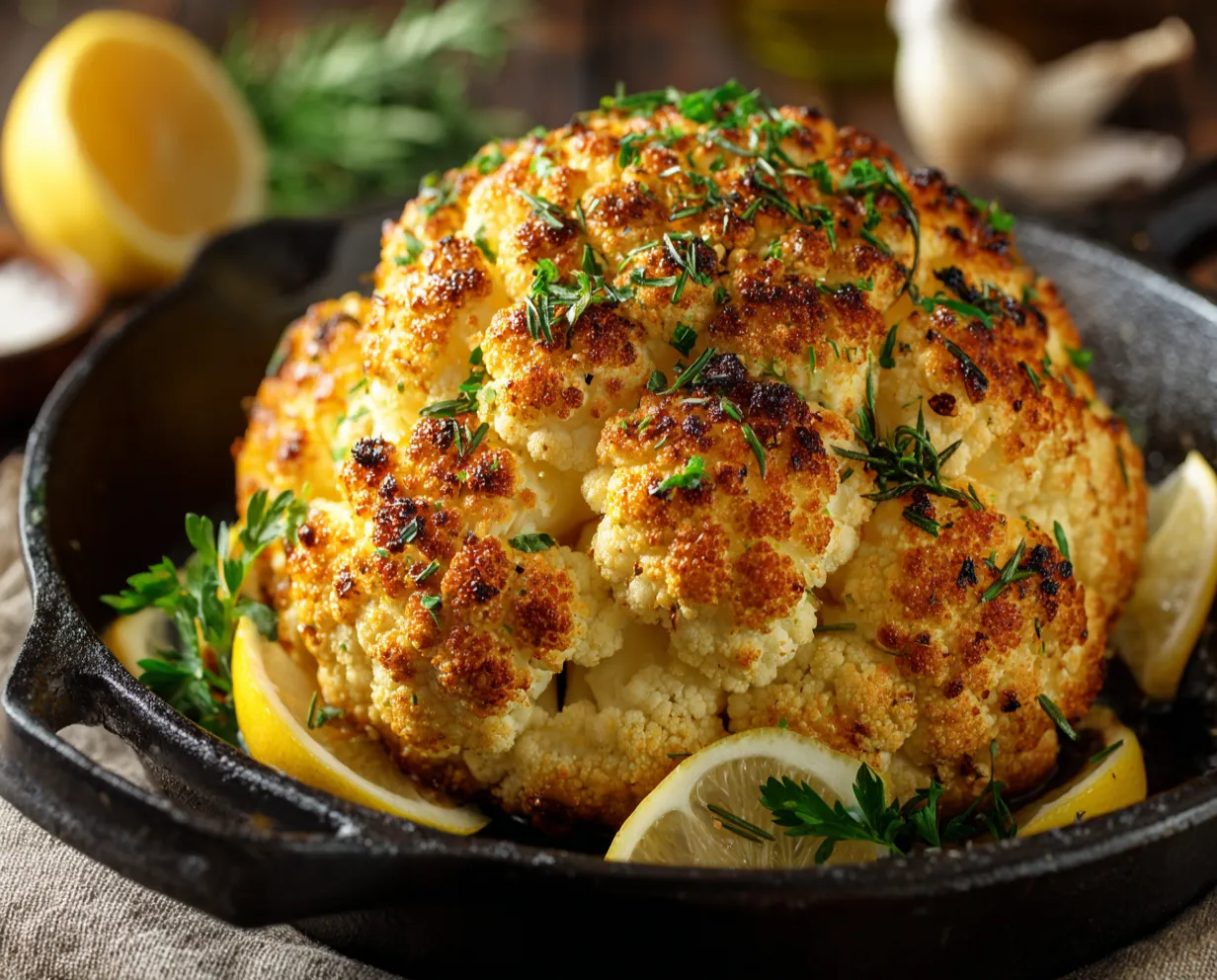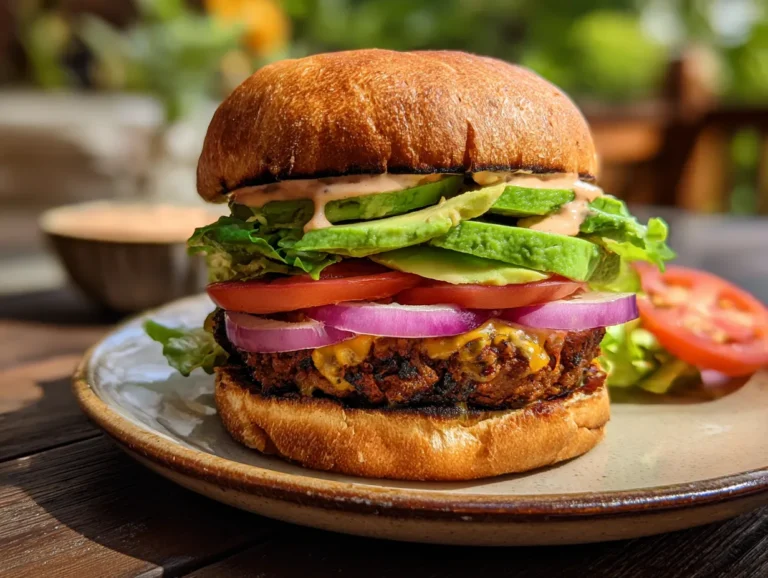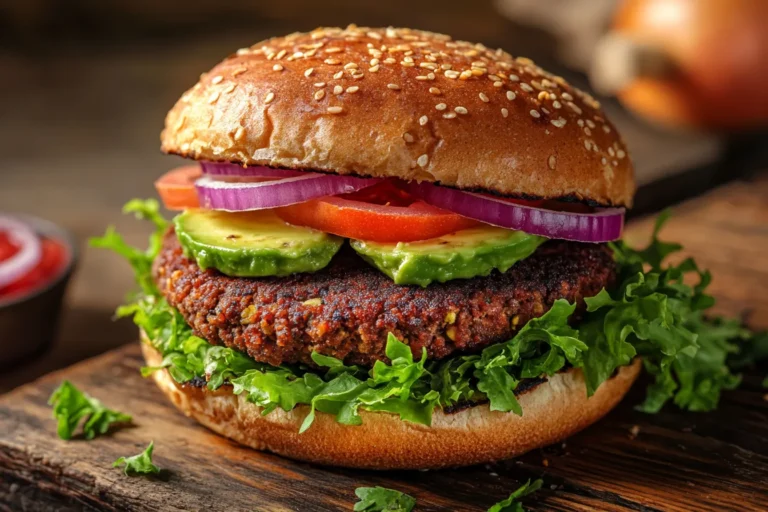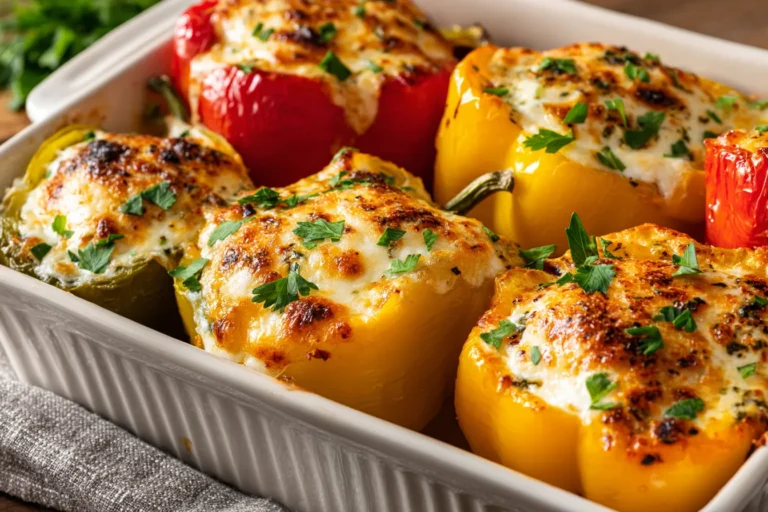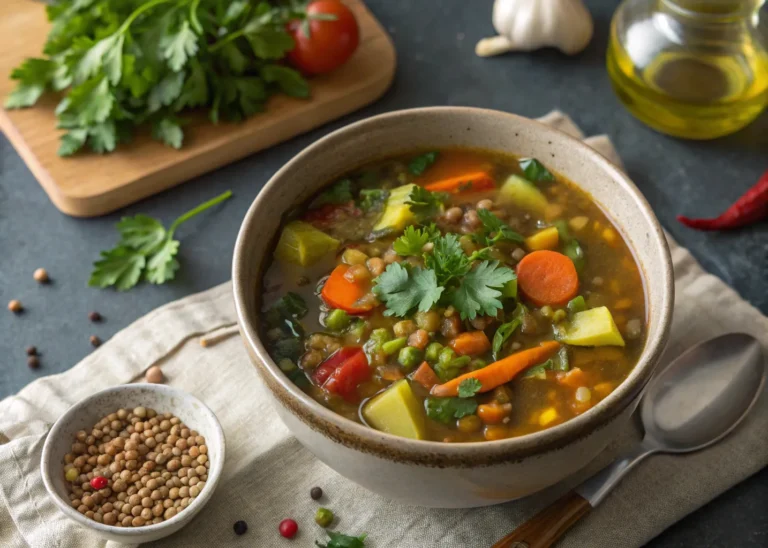Tired of bland vegetables? This whole roasted cauliflower recipe flips the script. It’s bold, golden, and packed with flavor — all from one simple ingredient and your oven. Whether you’re eating plant-based or just want a meat-free main that looks impressive, this dish delivers. No fancy skills required — just a few pantry staples and a craving for something satisfying.
I’ve made this recipe so many times—it’s one of my easiest crowd-pleasers, and always gets compliments.
Why Whole Roasted Cauliflower Deserves a Spot on Your Table
What Makes It So Popular?
Whole roasted cauliflower has taken over dinner tables—and for good reason. It’s budget-friendly, naturally gluten-free, and totally vegan. But more than that, it transforms a simple veggie into something with real wow factor. When roasted whole, cauliflower becomes tender on the inside and beautifully caramelized on the outside, almost like a plant-based roast.
Discover great ideas like Mexican Street Corn Recipe — perfect for serving alongside bold, golden dishes like this for a vibrant, crowd-pleasing combo.
This dish is Instagram-worthy, satisfying, and flexible enough to pair with just about anything. Serve it as a main course or a dramatic side—either way, it’ll get people talking.
Benefits of Cooking Cauliflower Whole
Roasting a whole cauliflower does more than just look impressive. It:
- Locks in moisture, giving you a juicy texture without mushiness.
- Enhances natural sweetness with caramelization.
- Makes seasoning easy, letting flavors soak deep into every bite.
- Keeps nutrients intact, compared to boiling or steaming.
Plus, it’s a breeze to prepare. One head, one pan, one oven—and you’re set.
Great for Vegan, Gluten-Free, and Low-Carb Diets
Whether you’re meal-prepping for the week or serving up something special for guests with dietary needs, whole roasted cauliflower checks all the boxes. It’s:
- 100% plant-based
- Naturally gluten-free
- Low in carbs, making it keto and paleo-friendly
- Rich in fiber, antioxidants, and vitamin C
No need to modify or compromise—this is one of those rare recipes that fits almost every lifestyle right out of the gate.
Ingredients You’ll Need (Simple Pantry Staples)
Main Ingredients: Cauliflower, Olive Oil, Garlic & Spices
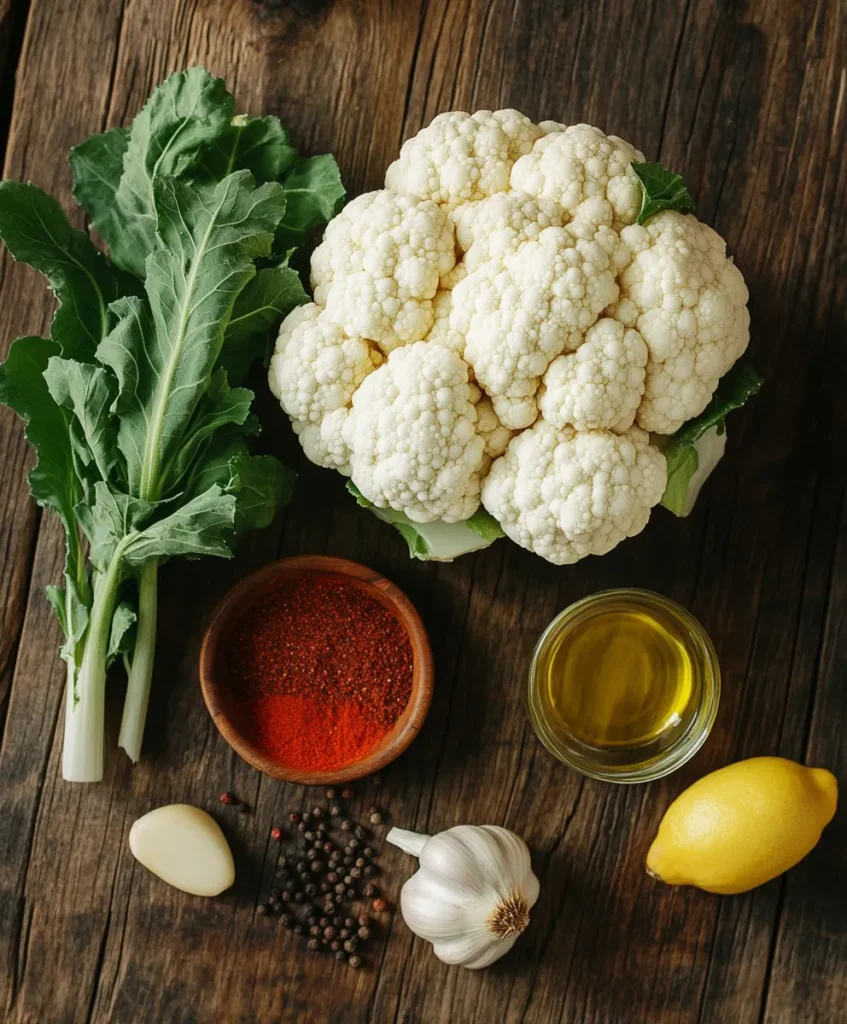
You don’t need a long grocery list to make a stunning whole roasted cauliflower. Here’s exactly what you’ll need:
| Ingredient | Purpose |
|---|---|
| 1 whole cauliflower head | The star of the show — firm, fresh, and tightly packed |
| Olive oil | Helps crisp up the outer layer and lock in flavor |
| Garlic (minced or powder) | Adds deep, aromatic notes throughout |
| Smoked paprika | For color and subtle smoky flavor |
| Salt & black pepper | Basic seasoning that makes a big difference |
| Lemon juice | Brightens the flavor and balances richness |
These ingredients form the base version, but they leave room for custom flavors depending on your taste.
Pro tip: Always choose a cauliflower that’s compact and unblemished. The firmer the head, the better it holds up during roasting.
Optional Add-ons for Flavor Boost
Want to go beyond the basics? These pantry extras can level things up without adding any fuss:
- Tahini or vegan yogurt – for a creamy drizzle post-roast
- Cumin or coriander – for a Middle Eastern spin
- Turmeric – adds color, earthiness, and anti-inflammatory benefits
- Chili flakes or harissa – for those who like heat
- Nutritional yeast – a cheesy, umami-rich touch without dairy
- Fresh herbs like parsley or cilantro – for a pop of freshness
Whether you keep it classic or dress it up, the base remains super forgiving and full of flavor.
Best Substitutions If You’re Missing Something
If you don’t have smoked paprika, regular paprika or a pinch of chili powder works just as well. Out of fresh garlic? Garlic powder is a great substitute. Not into lemon? A splash of apple cider vinegar adds the same tangy brightness.
This recipe is made for real home cooks, so don’t stress. Use what you’ve got, and make it yours.
How to Prep Your Whole Roasted Cauliflower for the Oven
Trimming and Cleaning the Cauliflower Head
Before we roast, we prep. A great whole roasted cauliflower starts with how you clean and trim it.
Rinse the cauliflower head under cool running water to remove any dirt or debris. Gently peel off the outer green leaves with your hands or a paring knife. Then use a sharp knife to trim the stem at the base, just enough so it can sit flat in your pan or dish—but don’t cut too deep or the florets may fall apart.
Now here’s the part many skip: drying the cauliflower. Whether you’ve just washed it or you plan to boil it briefly (more on that in a second), make sure the head is fully dry. Moisture is the enemy of that crispy, golden crust we’re after. Pat it dry with paper towels or a clean kitchen cloth. Don’t rush this step.
Should You Parboil Before Roasting?
For some, parboiling might feel like an extra step—but if you’re working with a particularly large head of cauliflower or want a more tender center, it’s worth it.
To parboil:
- Heat a large pot of water with salt until it reaches a gentle boil.
- Place the whole cauliflower head stem-side down.
- Let it cook for about 5–7 minutes, then remove it and let it cool slightly.
- Again—dry it completely.
Parboiling helps reduce roast time and ensures the inside is buttery soft while the outside still gets nice and crisp.
Pro Tip: Skip parboiling for small- to medium-sized cauliflower heads. Just season well and go straight to the oven.
Why Drying Is Key for Crispy Results
If your cauliflower is still wet when it goes in the oven, it will steam—not roast. And we’re not here for steamed cauliflower today.
Whole roasted cauliflower needs dry heat to caramelize on the outside and get that irresistible golden color. So don’t skip the drying—it’s the easiest way to upgrade your final result.
Roasting Your Whole Cauliflower to Perfection
The Best Oven Temperature and Time for Roasting
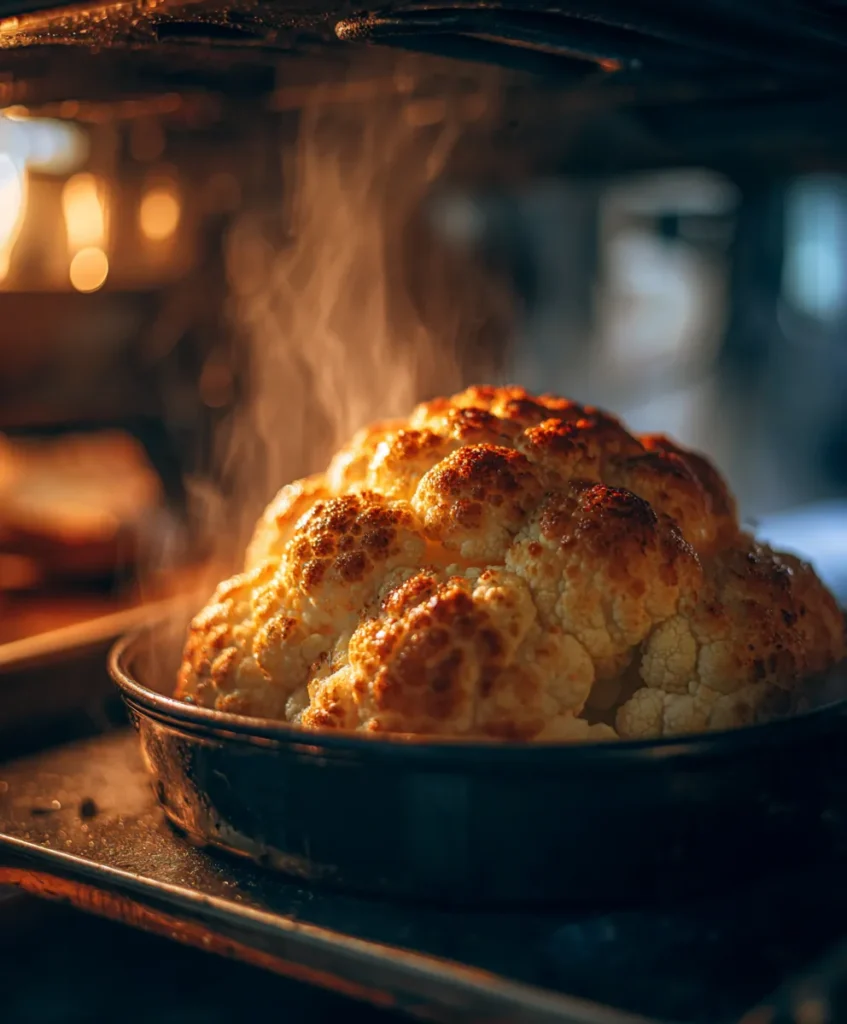
The perfect whole roasted cauliflower is cooked all the way through, has a crispy outer crust, and a deep golden color. Here’s the time and temp that gets it done:
- Bake at 400°F (200°C) for 45 to 60 minutes
The cooking time varies based on the size of your cauliflower. To test for doneness, insert a sharp knife or skewer into the center—if it goes in smoothly without resistance, it’s ready.
If you’re short on time or want an extra-roasted finish, bump the temperature up to 425°F for the final 10–15 minutes. That’ll give you a deeper color and crispier edges.
Should You Cover the Cauliflower While Roasting?
Yes—at least for part of the time. Start by loosely covering it with foil for the first 25–30 minutes. This traps a bit of moisture to help cook the inside.
After that, remove the foil so the outside can brown beautifully.
This two-step method guarantees a whole roasted cauliflower that’s soft in the center and beautifully golden on the outside.
How to Get That Crispy, Golden Crust
- Use plenty of olive oil. Don’t be shy. The oil helps everything brown.
- Baste during roasting. Halfway through, spoon the hot oil from the bottom of the pan over the cauliflower. Instant flavor boost.
- Roast uncovered for the final stretch. That’s when the crust really happens.
- Use a cast iron skillet or baking sheet for even heat.
Want to take it up a notch? Sprinkle a little smoked paprika, nutritional yeast, or chili flakes before that final blast of heat.
Flavor Variations to Try With Whole Roasted Cauliflower
One of the best things about whole roasted cauliflower is how incredibly customizable it is. The base recipe is simple and delicious on its own—but with just a few tweaks, you can take it in so many bold, flavorful directions.
Here are a few of our favorite variations to inspire your next roast:
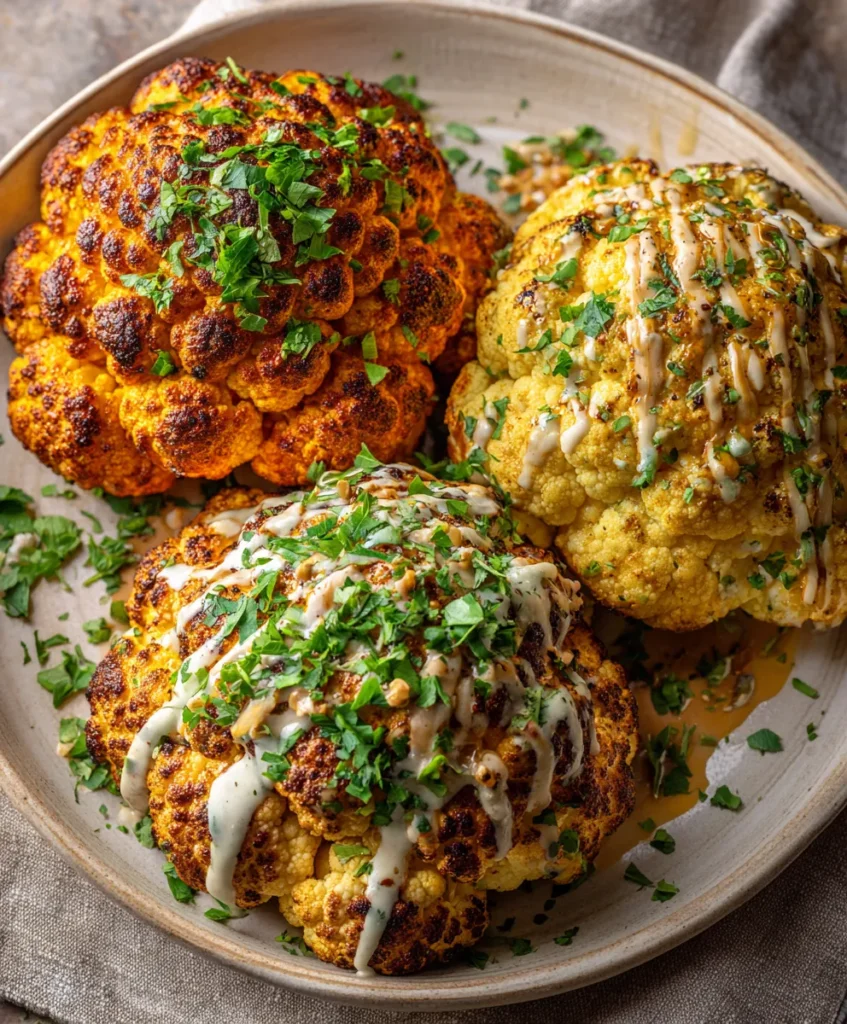
Garlic Herb Butter (Vegan-Friendly)
Blend olive oil with minced garlic, dried oregano, thyme, and a pinch of rosemary. Add a bit of lemon zest for brightness. Brush generously all over the cauliflower before roasting. This gives your whole roasted cauliflower that rich, herby aroma that smells like it came straight out of a cozy kitchen in Tuscany.
Want to keep it dairy-free? Just use vegan butter or olive oil—it works perfectly.
Spicy Harissa Cauliflower
Mix olive oil with a spoonful of harissa paste, cumin, coriander, and a little maple syrup. This variation gives your cauliflower a sweet-heat balance that’s smoky, bold, and totally unforgettable.
It’s the kind of twist that makes guests ask for the recipe before the meal even ends.
Indian-Inspired Tandoori Rub
Want to spice things up? Mix together turmeric, garam masala, ground cumin, smoked paprika, garlic powder, and plant-based yogurt (or coconut cream). Coat your whole roasted cauliflower generously before baking for an Indian flair that’s as colorful as it is flavorful.
Sprinkle with chopped cilantro and serve with a vegan raita or herbed tahini sauce.
Lemon-Tahini Glaze (Mediterranean-Style)
After roasting, drizzle your cauliflower with a simple lemon-tahini sauce made from tahini, lemon juice, garlic, water, and a pinch of salt. Top with toasted sesame seeds or pine nuts for crunch.
It’s clean, creamy, and fresh—perfect for spring or summer menus.
What to Serve With Whole Roasted Cauliflower
Whole roasted cauliflower is more than just a side dish—it can easily become the main event. Whether you’re building a plant-based plate or serving it alongside other dishes, here’s how to round out the meal.
Great as a Main Dish or a Shareable Centerpiece
When seasoned well and roasted just right, a whole cauliflower can feel hearty and satisfying. Slice it into thick wedges and serve it with your favorite sauce or glaze. Add a grain or protein on the side, and you’ve got a full meal that satisfies meat-eaters and plant-lovers alike.
This is the kind of recipe that looks amazing on a dinner table—especially for the holidays or weekend get-togethers.
Perfect Pairings: Grains, Greens & Sauces
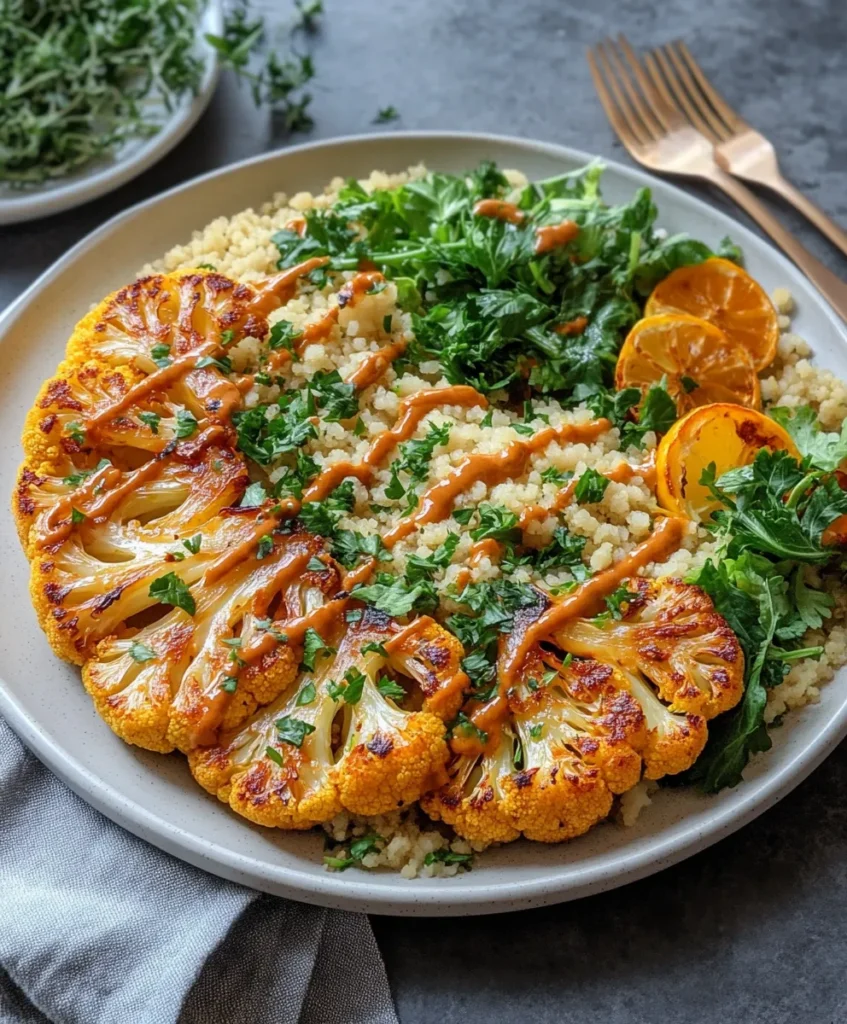
Pair your cauliflower roast with:
- Fluffy quinoa or couscous
- Roasted sweet potatoes or carrots
- Garlicky sautéed greens
- Herby rice pilaf or wild rice
- Creamy hummus or tahini sauce
- Fresh green salad with lemon vinaigrette
Check out Vegan Lentil Soup Recipe for a warm, filling option that complements this dish beautifully.
These sides add color, nutrition, and texture to balance the richness of the roast.
How to Build a Complete Vegan Meal
Turn this into a satisfying plant-based dinner by:
- Serving with a hearty lentil stew or chickpea curry
- Adding a side of grilled flatbread or pita
- Topping with toasted nuts or seeds for crunch
- Including a simple dip like baba ganoush or hummus for depth
Whole roasted cauliflower can do it all—main dish, side, holiday centerpiece, or weekly staple. It’s up to you.
Common Mistakes to Avoid When Making Whole Roasted Cauliflower
Even though whole roasted cauliflower is simple, there are a few common mistakes that can make the difference between “just okay” and absolutely unforgettable. Avoiding these errors ensures your cauliflower turns out golden, flavorful, and fully cooked every time.
Underseasoning the Core
It’s easy to focus all your seasoning on the outer layer—but that’s where many home cooks go wrong. The flavor needs to get inside, too. After trimming your cauliflower, flip it over and rub the seasoning into the base and crevices. That way, every slice is packed with flavor—not just the crust.
Skipping the Drying Step
Moisture is the enemy of browning. Whether you rinse or parboil your cauliflower, make sure it’s fully dry before you oil it. Any water left on the surface will cause steam in the oven and lead to soggy results instead of that beautifully browned crust.
Using Too Little Oil
Trying to keep things low-fat? That’s fine—but using too little oil is a guaranteed way to get dry, unevenly roasted cauliflower. The oil not only adds flavor but also helps achieve that perfectly caramelized exterior. Be generous—but not excessive.
Cutting Before Resting
Just like a good roast, your whole roasted cauliflower needs to rest for 5–10 minutes after coming out of the oven. Cutting into it right away can lead to steam loss and a dry interior. Let it sit, let the juices settle, then slice and serve.
Looking for inspiration? Try Vegetarian Stuffed Bell Peppers — another oven-roasted favorite that brings big flavor to your plant-based table.
Storage, Meal Prep & Reheating Tips
Whether you’re meal prepping for the week or saving leftovers from dinner, whole roasted cauliflower is super easy to store, reheat, and reuse in new meals.
How to Store Leftovers the Right Way
Once the cauliflower has cooled completely, store it in an airtight container in the fridge. You can either keep it whole or slice it into wedges for easy reheating.
- Fridge: Keeps well for up to 4 days
- Freezer: Yes, you can freeze it! Slice it first and store for up to 1 month in a freezer-safe container
Pro Tip: If freezing, roast the cauliflower slightly underdone so it doesn’t overcook when reheated.
Best Way to Reheat Without Losing Texture
To reheat and keep that crisp texture:
- Oven method (recommended): Preheat to 375°F, place slices on a baking sheet, and bake for 10–15 minutes.
- Air fryer option: Great for a quick reheat—5–7 minutes at 350°F.
- Microwave: Useful in a pinch, though it may soften the crust. Best suited for reheating smaller portions.
Skip the skillet—it can get mushy fast.
Creative Ways to Use Leftover Roasted Cauliflower
Get more out of your meal with these ideas:
- Slice and stuff into wraps with hummus and greens
- Toss into a grain bowl alongside quinoa, creamy avocado, and a drizzle of tahini.
- Chop and toss into a warm pasta or lentil salad
- Use in tacos with spicy slaw and lime crema
- Blend into a creamy cauliflower soup for lunch the next day
Whole roasted cauliflower is more than just a one-dish wonder—it’s the gift that keeps on giving in your kitchen.
FAQs About Whole Roasted Cauliflower
How do you keep whole roasted cauliflower from drying out?
The key is moisture and oil. Make sure to cover it with foil during the first half of baking to trap steam, then uncover to brown the outside. Also, brushing generously with olive oil helps seal in moisture and create a crispy crust.
Can you roast cauliflower without boiling it first?
Absolutely. Parboiling is optional—it simply speeds up roasting and helps the center get tender faster. For medium-sized heads, you can skip it and still get great results by roasting at 400°F for 50–60 minutes.
What temperature should cauliflower be roasted at?
The ideal temperature for whole roasted cauliflower is 400°F (200°C). This allows the inside to cook through while the outside turns golden and caramelized. For extra browning, increase to 425°F in the final 10–15 minutes.
How do you know when whole cauliflower is done?
Insert a knife or skewer into the center—if it slides in easily with no resistance, your cauliflower is perfectly roasted. You should also see deep golden coloring on the exterior.
Is whole roasted cauliflower healthy?
Yes! It’s naturally low in calories, gluten-free, vegan, and packed with fiber, vitamin C, and antioxidants. It’s a great meatless main or side dish for a balanced plant-based meal.
Can I prepare whole roasted cauliflower in advance?
Definitely. You can season it and refrigerate it uncooked for up to 24 hours before roasting. Or, roast it fully and reheat slices in the oven when ready to serve. Just make sure it’s stored in an airtight container to keep it fresh.
Conclusion: A Stunning Plant-Based Dish That Delivers Every Time
Whole roasted cauliflower proves you don’t need meat to make a main dish that’s bold, beautiful, and packed with flavor. With a handful of ingredients and a little oven magic, this simple vegetable transforms into something that feels special enough for a holiday but easy enough for weeknight dinner.
It’s versatile, satisfying, and ready to play the main role—or support one—as part of your healthy, plant-based lifestyle.
It’s one of those recipes I keep coming back to—reliable, simple, and always a hit.
Don’t miss our Black Bean Burger Recipe if you’re craving another easy, satisfying vegan main that’s loaded with flavor.
Give it a try, and it could easily earn a spot in your weekly rotation.
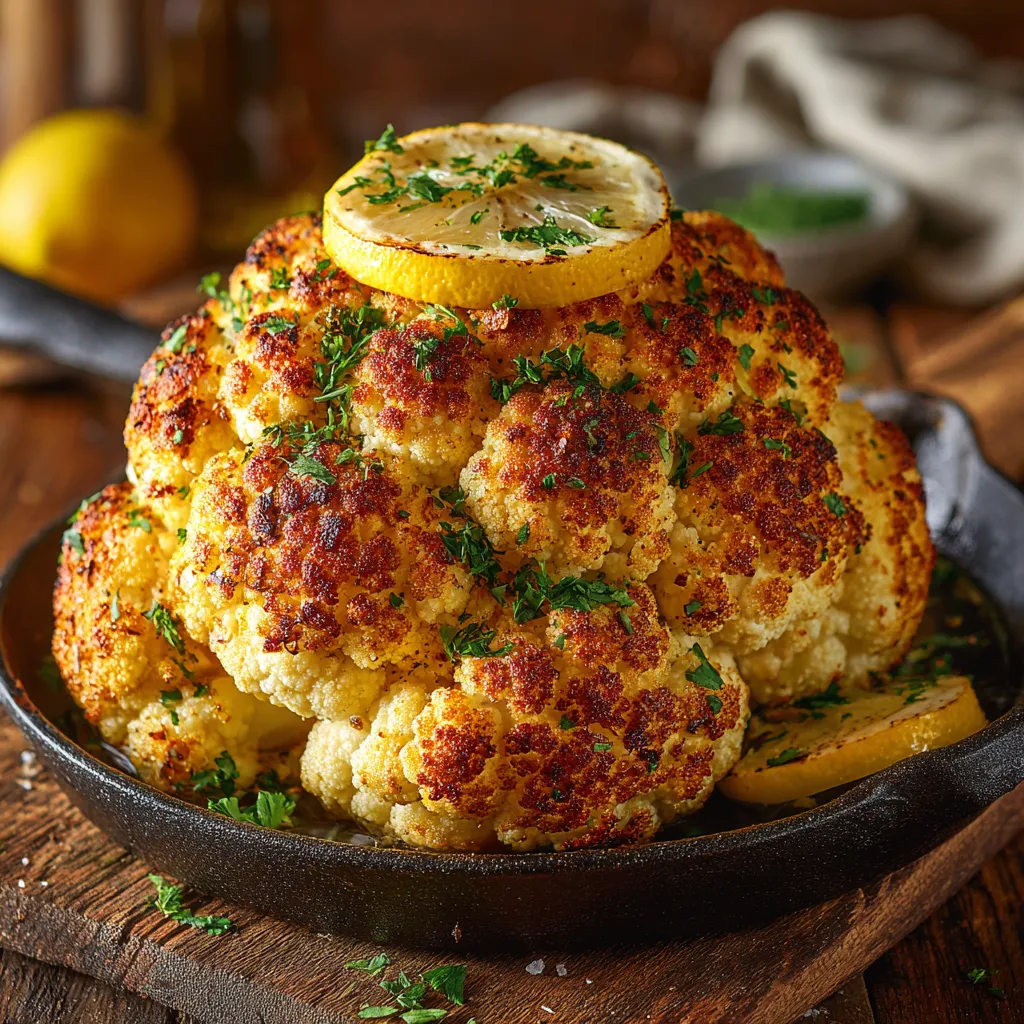
Whole Roasted Cauliflower
Ingredients
Equipment
Method
- Preheat your oven to 400°F (200°C). Line a baking sheet or use a cast iron skillet.
- Trim the leaves and stem from the cauliflower, keeping the head intact. Rinse and dry thoroughly.
- Mix olive oil, garlic, paprika, salt, pepper, and lemon juice in a bowl.
- Flip the cauliflower upside down and pour some of the seasoning into the base. Use a brush to coat the entire head evenly.
- Cover loosely with foil and roast for 30 minutes.
- Remove foil, baste with pan juices, and return to the oven for another 20–30 minutes until golden and tender.
- Let rest for 5–10 minutes. Slice and garnish with herbs before serving.
Notes
- For extra flavor, let the cauliflower marinate in the seasoning for 30 minutes before roasting.
- If using a larger cauliflower, increase roasting time by 10–15 minutes and test with a knife for doneness.
- Swap lemon juice with apple cider vinegar for a tangy twist if citrus isn’t your thing.
- Add a pinch of chili flakes or a drizzle of tahini sauce after roasting to create new flavor layers.
- Use parchment paper or foil under the cauliflower to make cleanup easier.
- This whole roasted cauliflower also works great sliced into steaks and served over quinoa or couscous bowls.
- Leftovers can be chopped and used in wraps, grain bowls, or tossed into salads the next day.


